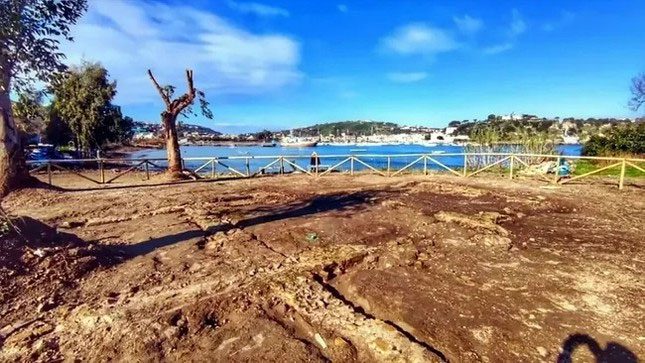Ancient Luxury Villa Ruins from the 1st Century Discovered Near Mount Vesuvius May Be Where Pliny the Elder Witnessed the Catastrophic Eruption.
Archaeologists believe that this luxurious villa is the site where Pliny the Elder first witnessed the massive volcanic eruption that would later claim his life.
A dig conducted to build a playground near Naples, Italy, has uncovered an ancient coastal villa believed to be the location where the Roman philosopher Pliny the Elder observed the eruption of Mount Vesuvius in 79 AD.
The eruption destroyed Pompeii and devastated other towns in the area, potentially killing up to 16,000 people, including Pliny himself.

Remains of the luxurious villa found at Punta Sarparella in Bacoli, which in the 1st century was the port city of Misenum, where Pliny the Elder commanded a Roman fleet.
Pliny, whose full name was Gaius Plinius Secundus, is famous for sailing from his home to the eruption site in an attempt to rescue those affected. His nephew and adopted son, Pliny the Younger (Gaius Plinius Caecilius Secundus), wrote in a letter that he witnessed Pliny’s death just hours later as he was engulfed by toxic fumes from the volcano.
The newly excavated villa is located in Punta Sarparella, northwest of Naples in the town of Bacoli, which in the 1st century was the port city of Misenum where Pliny the Elder commanded a Roman naval fleet.
While archaeologists suggest that the villa could also belong to another wealthy Roman, its features align with Pliny’s descriptions and it offers a spectacular view of Mount Vesuvius, about 30 km away across the bay.
An Italian Ministry of Culture representative stated: “The newly constructed villa provides maximum visibility of the entire harbor basin and a wide view of the entire bay.”
Villa with a Banquet Garden
Simona Formola, an archaeologist from the Italian Ministry of Culture, noted that some remaining walls of the villa are constructed from soft limestone blocks called tufa, arranged decoratively like a net, extending out to the beach and into the water.
It is believed that Pliny hosted many Roman elites at garden banquets in the villa. If the villa belonged to Pliny, it would be one of several he maintained in picturesque locations across Italy.
Archaeological excavations will continue over the coming months; researchers hope to learn more about the villa itself as well as Misenum, an important Roman naval base.
Formola told CNN that excavating deeper layers could reveal more rooms in the villa and possibly even frescoes.
Who Was Pliny?
Pliny was born into a wealthy Roman family and advanced in the Roman Army. At the age of 50, he was appointed as the commander of the Misenum fleet, a force tasked with protecting the coast from pirates. He was also a prolific writer. Many of his books are now lost, but he is best known for his work “Natural History,” in which he attempted to document everything known about the world.
Sue Alcock, an archaeologist at the University of Oklahoma, stated: “Natural History remains a classic today; some argue it is the first encyclopedia ever written.”
Alcock added: “The work consists of 37 volumes and presents contemporary knowledge on zoology, botany, geology, mineralogy, astronomy, and technology, as well as a nearly unique discussion of art and artists in his time.”
After witnessing the eruption, possibly in October of 79 AD, and rushing to save friends, he was warned of the dangers but quoted the Latin proverb “Fortune favors the bold” (Audentes Fortuna Iuvat) and set out, only to die a few hours later on the coast of Stabiae after sailing across the Bay of Naples.
Alcock noted that Pliny’s words may not be original, but they still exist as one of the most famous quotes.


















































